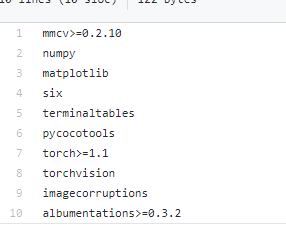첫째, 시스템 환경
공동 과학 기술 상 나라, 홍콩 오픈 소스의 중국 대학은 깊은 표적 탐지 키트 mmdetection 소스 주소를 학습
Ubuntu16.04
Cuda9.0 + cudnn7.5
Python3.6
GCC 7.2
Anaconda3
둘째, 환경 구성
공식 구성 튜토리얼 (자습서가 추천하는 등의 행위)
CONDA를 사용하여 가상 환경을 만들기 (1)
conda create -n mmdetection python=3.6
source activate mmdetection사용할 준비가 아나콘다 미러 소스
conda config --add channels https://mirrors.tuna.tsinghua.edu.cn/anaconda/pkgs/free/
conda config --add channels https://mirrors.tuna.tsinghua.edu.cn/anaconda/cloud/conda-forge
conda config --add channels https://mirrors.tuna.tsinghua.edu.cn/anaconda/cloud/msys2/
# 设置搜索时显示通道地址
conda config --set show_channel_urls yes
安装pytorch需要添加pytorch源
conda config --add channels https://mirrors.tuna.tsinghua.edu.cn/anaconda/cloud/pytorch/
pytorch를 설치합니다
명령의 공식 웹 사이트에 직접 pytorch 설치하지만, 그렇지 않으면 -c 파이썬 pytorch 칭화 소스를 제거하는 데 사용되어서는 안된다
예를 들어, 내 CUDA 9.0, 내가하는 데 사용되는 명령입니다
conda install pytorch==1.1.0 torchvision==0.3.0 cudatoolkit=9.0
#其中cudatoolkit只是一个cuda的工具包3.clone웨어 하우스
git clone https://github.com/open-mmlab/mmdetection.git
cd mmdetection명령을 실행하십시오
python setup.py develop(이 명령은 자동으로 매우 느리게 다음과 같은 패키지를 다운로드 할 수 있지만 있지만) 포장 다음을 실행하기 전에 추천합니다

mmdetection 단계가 완료되었습니다. Demo.py는 테스트 파 파일을 만들 수 있습니다. (모델, 아마존 클라우드 서버에 저장 속도가 느려집니다 다운로드)
from mmdet.apis import init_detector, inference_detector, show_result
import mmcv
config_file = 'configs/faster_rcnn_x101_32x4d_fpn_1x.py'
checkpoint_file = 'checkpoints/faster_rcnn_x101_32x4d_fpn_2x_20181218-0ed58946.pth'
# build the model from a config file and a checkpoint file
model = init_detector(config_file, checkpoint_file, device='cuda:0')
# test a single image and show the results
img = 'test.jpg' # or img = mmcv.imread(img), which will only load it once
result = inference_detector(model, img)
# visualize the results in a new window
show_result(img, result, model.CLASSES)
# or save the visualization results to image files
#show_result(img, result, model.CLASSES, out_file='result.jpg')
# test a video and show the results
'''
video = mmcv.VideoReader('video.mp4')
for frame in video:
result = inference_detector(model, frame)
show_result(frame, result, model.CLASSES, wait_time=1)
세 -VOC 교육 및 테스트 데이터 세트 형식
1. 데이터 세트의 저장 위치 (서버가 이미이 데이터 세트가있는 경우, 우리는 소프트 링크를 사용하는 것이 좋습니다)
mmdetection
├── mmdet
├── tools
├── configs
├── data
│ ├── VOCdevkit
│ │ ├── VOC2007
│ │ │ ├── Annotations
│ │ │ ├── JPEGImages
│ │ │ ├── ImageSets
│ │ │ │ ├── Main
│ │ │ │ │ ├── test.txt
│ │ │ │ │ ├── train.txt
|—— trainval.txt
2 코드 변경
①mmdet / 세트 / voc.py, 분류하는 카테고리 자신의 데이터 세트를 넣습니다.
②mmdet / 코어 / 평가 / class_name.py의 voc_classes의 내부 ()는 자신의 데이터 세트의 범주를 변경합니다.
설정 파일을 수정 ③, 나는 다음과 같은 샘플을 사용 RetinaNet
# model settings
model = dict(
type='RetinaNet',
pretrained='open-mmlab://resnext101_32x4d',
backbone=dict(
type='ResNeXt',
depth=101,
groups=32,
base_width=4,
num_stages=4,
out_indices=(0, 1, 2, 3),
frozen_stages=1,
style='pytorch'),
neck=dict(
type='FPN',
in_channels=[256, 512, 1024, 2048],
out_channels=256,
start_level=1,
add_extra_convs=True,
num_outs=5),
bbox_head=dict(
type='RetinaHead',
num_classes=21, #修改为自己数据集的类别数+1
in_channels=256,
stacked_convs=4,
feat_channels=256,
octave_base_scale=4,
scales_per_octave=3,
anchor_ratios=[0.5, 1.0, 2.0],
anchor_strides=[8, 16, 32, 64, 128],
target_means=[.0, .0, .0, .0],
target_stds=[1.0, 1.0, 1.0, 1.0],
loss_cls=dict(
type='FocalLoss',
use_sigmoid=True,
gamma=2.0,
alpha=0.25,
loss_weight=1.0),
loss_bbox=dict(type='SmoothL1Loss', beta=0.11, loss_weight=1.0)))
# training and testing settings
train_cfg = dict(
assigner=dict(
type='MaxIoUAssigner',
pos_iou_thr=0.5,
neg_iou_thr=0.4,
min_pos_iou=0,
ignore_iof_thr=-1),
allowed_border=-1,
pos_weight=-1,
debug=False)
test_cfg = dict(
nms_pre=1000,
min_bbox_size=0,
score_thr=0.05,
nms=dict(type='nms', iou_thr=0.5),
max_per_img=100)
# dataset settings
dataset_type = 'VOCDataset'
data_root = 'data/VOCdevkit/'
img_norm_cfg = dict(
mean=[123.675, 116.28, 103.53], std=[58.395, 57.12, 57.375], to_rgb=True)
train_pipeline = [
dict(type='LoadImageFromFile'),
dict(type='LoadAnnotations', with_bbox=True),
dict(type='Resize', img_scale=(1333, 800), keep_ratio=True),
dict(type='RandomFlip', flip_ratio=0.5),
dict(type='Normalize', **img_norm_cfg),
dict(type='Pad', size_divisor=32),
dict(type='DefaultFormatBundle'),
dict(type='Collect', keys=['img', 'gt_bboxes', 'gt_labels']),
]
test_pipeline = [
dict(type='LoadImageFromFile'),
dict(
type='MultiScaleFlipAug',
img_scale=(1333, 800),
flip=False,
transforms=[
dict(type='Resize', keep_ratio=True),
dict(type='RandomFlip'),
dict(type='Normalize', **img_norm_cfg),
dict(type='Pad', size_divisor=32),
dict(type='ImageToTensor', keys=['img']),
dict(type='Collect', keys=['img']),
])
]
data = dict(
imgs_per_gpu=2,
workers_per_gpu=2,
train=dict(
type=dataset_type,
ann_file=data_root + 'VOC2007/ImageSets/Main/train.txt',
img_prefix=data_root + 'VOC2007/',
pipeline=train_pipeline),
val=dict(
type=dataset_type,
ann_file=data_root + 'VOC2007/ImageSets/Main/trainval.txt',
img_prefix=data_root + 'VOC2007/',
pipeline=test_pipeline),
test=dict(
type=dataset_type,
ann_file=data_root + 'VOC2007/ImageSets/Main/test.txt',
img_prefix=data_root + 'VOC2007/',
pipeline=test_pipeline))
# optimizer
optimizer = dict(type='SGD', lr=0.005, momentum=0.9, weight_decay=0.0001)
optimizer_config = dict(grad_clip=dict(max_norm=35, norm_type=2))
# learning policy
lr_config = dict(
policy='step',
warmup='linear',
warmup_iters=500,
warmup_ratio=1.0 / 3,
step=[8, 11])
checkpoint_config = dict(interval=1)
# yapf:disable
log_config = dict(
interval=50,
hooks=[
dict(type='TextLoggerHook'),
# dict(type='TensorboardLoggerHook')
])
# yapf:enable
# runtime settings
total_epochs = 32
device_ids = range(8)
dist_params = dict(backend='nccl')
log_level = 'INFO'
work_dir = './work_dirs/retinanet_x101_32x4d_fpn_1x'
load_from = None
resume_from = None
workflow = [('train', 1)]
네 훈련
python tools/train.py configs/RetinaNet.py --gpus 1 --gpus GPU 번호를 사용, 기본값은 첫 번째 카드 0이다
다섯 테스트
단지 파일 test.py 코코 데이터는 평가를 설정하기 때문에 그럼 eval_voc.py, PKL test.py 파일에 의해 생성 된 제 1 연산 맵
python tools/test.py configs/RetinaNet.py work_dirs/latest.pth --out=eval/result.pkl각 클래스 AP의 PKL 컴퓨터 파일을 사용하여
python tools/voc_eval.py eval/result.pkl configs/RetinaNet.py많은 사용 명령은 GitHub의에 튜토리얼을 참조
추천 도서
